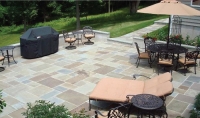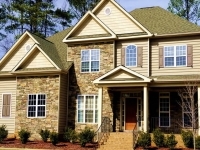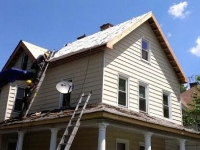Fireplace door question archived
Yes your damper serves a purpose. However, when you add glass doors you are changing the design of you fire place system and have to remove the damper as part of that change. Else, the house will fill with smoke or C0 if you are burning gas.
The fire place has to breath and exhaust the waste products out the top.
The fire place has to breath and exhaust the waste products out the top.
Probably the lever that operates the damper extends into the area that will be covered by the fireplace doors. You can, as an alternative, install a damper on the chimney that operates with a wire rope running down the flue.
jgberkeley,
Why cannot one keep the damper and open it when there is a fire going, keep it closed otherwise? By removing the damper one risks losing too much heat up the flue when there is no fire. Depending on the fireplace, closed glass doors may not seal as well as a closed damper. One can conserve heat better by having both the damper and the doors.
Why cannot one keep the damper and open it when there is a fire going, keep it closed otherwise? By removing the damper one risks losing too much heat up the flue when there is no fire. Depending on the fireplace, closed glass doors may not seal as well as a closed damper. One can conserve heat better by having both the damper and the doors.
If the system uses gas in any way, you must lock the damper open or remove it. That is the law.
If the system is wood, the damper is removed and the doors have air intakes that allow you to control the amount of air sucked into the fire box and out the flue.
A few years back we had quite a long discussion on fire places. I will look for the information.
The bottom line, standard fire places remove heat from your home. They look and feel good, but remove large amounts of heat.
High tech fire place conversions can produce usable heat and the nice look and feel. You will need fans, hardware and a lot of conversion work.
If the system is wood, the damper is removed and the doors have air intakes that allow you to control the amount of air sucked into the fire box and out the flue.
A few years back we had quite a long discussion on fire places. I will look for the information.
The bottom line, standard fire places remove heat from your home. They look and feel good, but remove large amounts of heat.
High tech fire place conversions can produce usable heat and the nice look and feel. You will need fans, hardware and a lot of conversion work.
xnyr,
Then look at the doors. On the bottom or the sides you will find vent slots which allow air to be sucked from your house into the fire box.
Some of the units have sliders to allow you to adjust the amount of air flow.
With this unit your damper should be full open, and the air vents will control the amount of air feeding the fire.
Want a softer slower fire, close down the air vents. Open them fully for a full flame.
Then look at the doors. On the bottom or the sides you will find vent slots which allow air to be sucked from your house into the fire box.
Some of the units have sliders to allow you to adjust the amount of air flow.
With this unit your damper should be full open, and the air vents will control the amount of air feeding the fire.
Want a softer slower fire, close down the air vents. Open them fully for a full flame.
I don't think you can suck air down the chimney to supply oxygen for a fire. New zero clearance fireplaces, both gas and wood, have a inlet to feed oxygen from outside the house.
Dec 7, 2006 at 3:22am Edited
jgb'y
thanks for the tip. the door does have air vents along the bottom and sides---just a vent---no controls. I only adjust the damper.
thanks for the tip. the door does have air vents along the bottom and sides---just a vent---no controls. I only adjust the damper.
We just had our chimney cleaned and the guy who came removed our damper as well. We have glass doors on our fireplace with the vents on the bottom. He said it should have been done when the doors were installed.
Is this a relatively new thing? Our doors were installed about four years ago by a reputable company in Summit. You'd think they would have told us to remove the damper.
Essentially the chimney guy told us that the house could fill with smoke if the damper were left in place. He said with a chimney cap and glass doors it was no longer needed.
Is this a relatively new thing? Our doors were installed about four years ago by a reputable company in Summit. You'd think they would have told us to remove the damper.
Essentially the chimney guy told us that the house could fill with smoke if the damper were left in place. He said with a chimney cap and glass doors it was no longer needed.
Thanks for all the comments.
We have a wood-burning fireplace. I'm confused on how the house would fill with smoke if I open the damper when I have a fire and close it when I don't (just like I usually do).
BoBK is right - our damper handle extends too far. But I figured the damper could be somehow altered so it could be opened and propped up vertically.
We have a wood-burning fireplace. I'm confused on how the house would fill with smoke if I open the damper when I have a fire and close it when I don't (just like I usually do).
BoBK is right - our damper handle extends too far. But I figured the damper could be somehow altered so it could be opened and propped up vertically.
"I'm confused on how the house would fill with smoke if I open the damper when I have a fire "
Easy, even when fully open the damper will restrict air flow. The air flow is controlled by the glass doors and vents.
Without full air flow the smoke will back up. So remove the damper to open the flue to the smoke shelf, and control all the air from the vents on the glass doors.
Easy, even when fully open the damper will restrict air flow. The air flow is controlled by the glass doors and vents.
Without full air flow the smoke will back up. So remove the damper to open the flue to the smoke shelf, and control all the air from the vents on the glass doors.
We have a glass door assembly on our fireplace and no chimney damper. That's the way it was when we bought the place. We use the fireplace a lot in the winter and never had any trouble. I believe this design is supposed to be more efficient in burning the wood and supposed to produce less smoke (out the chimney) once you really get the fire going. But I'm not expert on this, just that we use it and it works.
You can not reply as this discussion is Closed!
Sponsored Business
Promote your business here - Businesses get highlighted throughout the site and you can add a deal.















newtoallthis